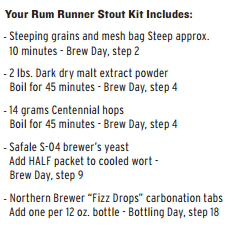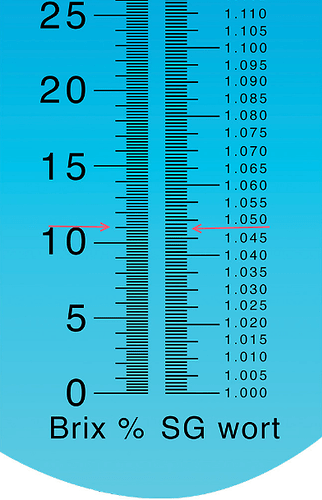When considering the different components to a brew what should I be looking at when it comes to the amount of grains, hops, malt (dry or wet), and yeast I should use. From my limited experience I am guessing that I would use half a packet of yeast for every gallon of beer I want to make. And when it comes to grains and malts, would I use a pound of each for every gallon, or is there a different ratio I should be looking at?
I start by looking at other recipes in the same style, and doing a little research. “Brewing classic styles” is a great resource. Look for patterns… what are others doing most often, what are weird outliers, etc.
Then, on to a brewing calculator. I use Beersmith, but there are others available. Start adding and subtracting, and see how it affects original gravity, color, IBUS.
In general, I try to stay to a pound or less of specialty grains per 5 gallons (I break this rule on my porter, but on light colored beers, it’s a good rule of thumb). A pack of yeast for 5 gallons up to 1.055 or so…
It does all depend. Look up some clones, or some of the NB kits, and look for patterns.
The BJCP is also a great place to look. These provide strict style guidelines for competition but gives you an idea of what the style is.
In regards to recipes, think about what you want, and what ingredients will get you there. Think about what each ingredient contributes and the likelihood it will do so. Remember, you can’t have it all and that some ingredients are stronger than others and will easily overshadow others.
Another thing to remember is that initially you’ll want to add 10 different types of malt and 8 hop varieties. Often this leads to a muddled beer with no direction.
Great advice from @uberculture. I write out multiple recipes from the web in my "shorthand " on a scratch sheet when researching a style to brew. Look for common threads/ ingredients and apply what You like also to the final draft, Er draught 
“My” first Lager recipe was a Vienna Lager lifted almost entirely from @mattnaik.(what happened to that guy, anyway?)
A plug also for the recipe builder tool from Brewers Friend.
Edit :and what Loopie said ,too. He types faster than me!
For all grain about 2lbs/gal will get you around 6% abv. Keep your Chrystal malts under 10%. Bittering hops 12-14aa 3/4 oz or under depending on your tolerance. Flavor hops is up to you. That’s old school without using one of those new fangled computer things.
Silly abacus’s.
Hmmm. I am wanting to get my feet wet with an oatmeal stout with possibly some coffee and chocolate flavors in there. I recently finished my second round with the Rum Runner stout kit from NB, which did not come out with the ABV I was hoping for, but I guess that is just another thing I will learn as I go along. I am guessing one problem I ran into was when I was adding the dry malt it started clumping (probably poured it in too fast) and possibly didn’t all get processed by the yeast during fermentation. I came out with a ABV of 2.3% according to my refractometer after about 2 and a half weeks of fermentation.
I purchased two one gallon recipe kits and combined them to make a little over 2 gallons. I think each one came with a pound of grains, and a pound of dry malt.
Measure with refracto after fermentation? Use a calc to correct for presence of alcohol?
Right, I got a 1.067 prior to fermentation, after the wort cooled. Then got a 1.047 after the 2 and a half weeks of fermentation.
Of course after drinking it seemed a bit higher, so I could be doing something wrong. Or I am just a light-weight when it comes to drinking. Either one could be true.
I’m sure you read that wrong… if you use a refractometer, for final gravity, you need to do a calculation to get your actual final gravity. If you really did finish that high, the beer would be undrinkably sweet. And a 13 year old couldn’t get tipsy off it.
Then, yeah, I must have done it wrong, as it is not sweet at all. Well, I have enough left in bottles I can certainly check it again. What calculation should I do after I get a reading?
Hope it’s not in bottles at that gravity
Why?
In addition to what has been said, get some recipe helper software. I use BeerSmith, but there are others.
It lets you compare your recipes to style. So if you want to do an overhopped Irish Red, you can tell it you’re doing an Irish red, and get everything to spec, and add more hops.
Probably not done fermenting
Not sure why you would consider it not being done fermenting. There was no activity in the fermenter when I went to bottle it. The recipe directions only called for a two week fermentation.
If it was the Rum Runner kit, this is the ingredients list (http://www.northernbrewer.com/documentation/beerkits/RumRunnerStout_ONEGALLON) at the NB web site

The kit instructions show 2 lb of DME. DME is 44 gravity points per pound, so the typical OG for this recipe would be around 1.088.
Here’s a calculator…
With a refractometer, it makes life easier to stay in Brix. Plugging in your numbers, it looks like you’re at about twice the ABV you expected. That still seems off, though. I think either your refractometer isn’t reading right, or you measured some watered down wort for OG…
When you measured the FG using the refractometer, did you use the BRIX number (plus a conversion) or read the SG number directly to get the FG of 1.047?
Both times I used the scale on the right.
